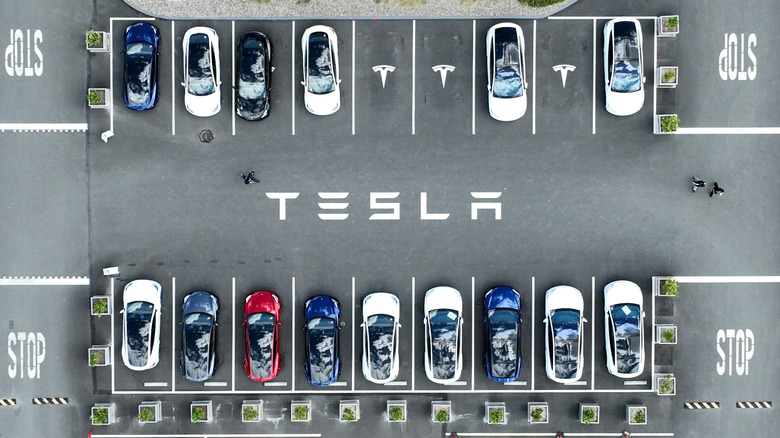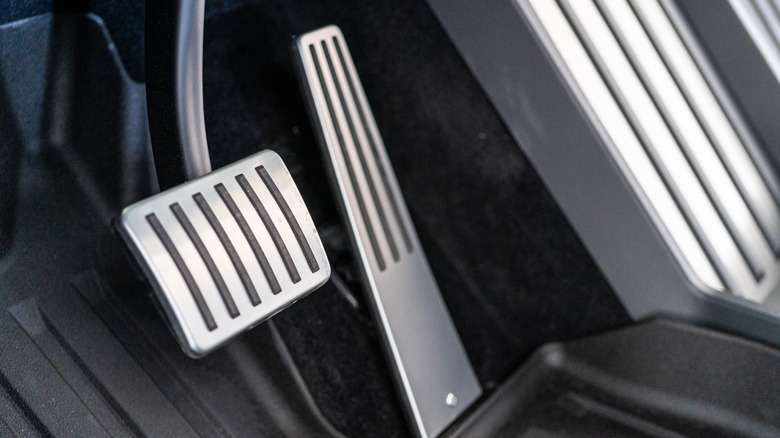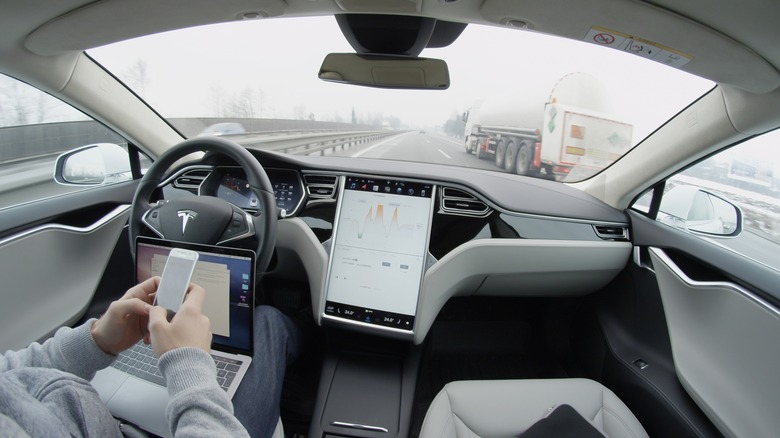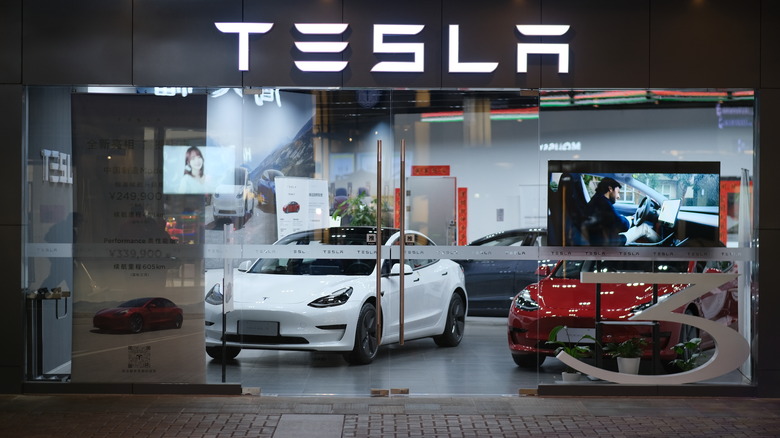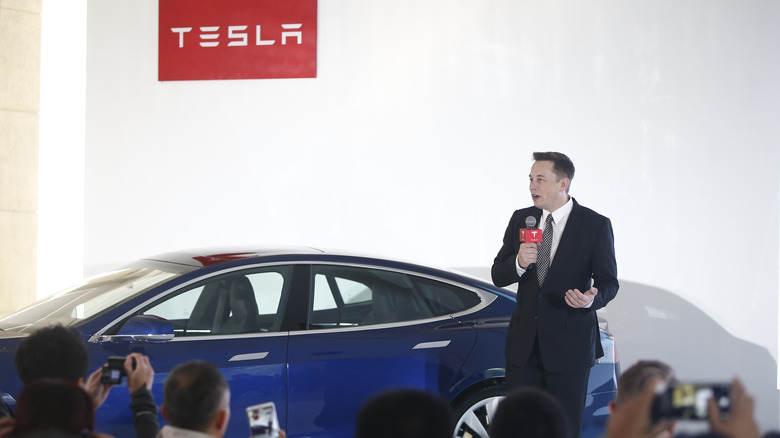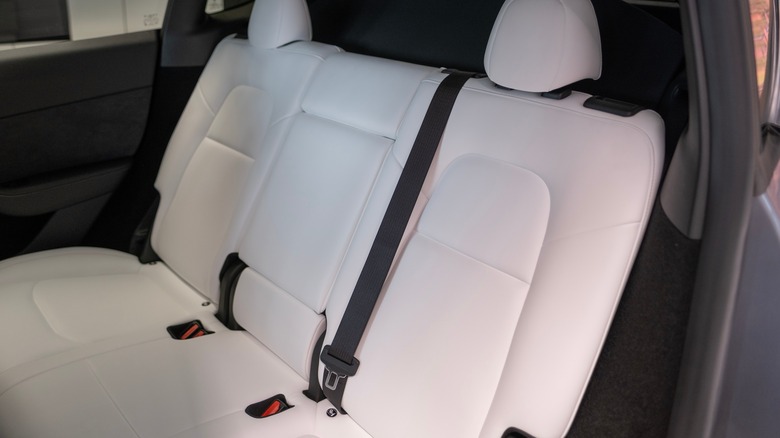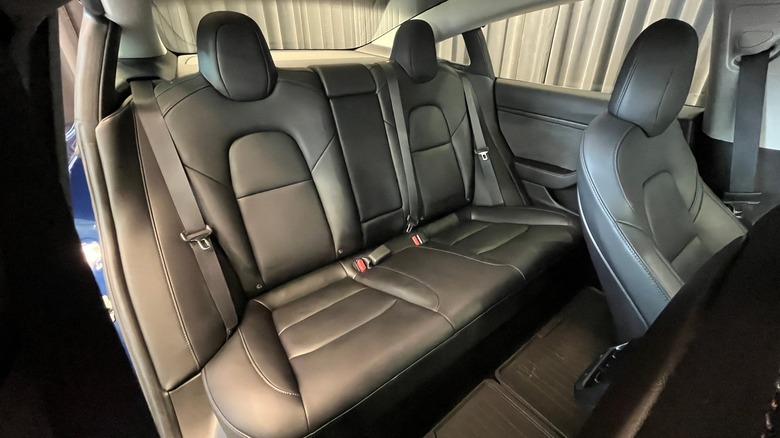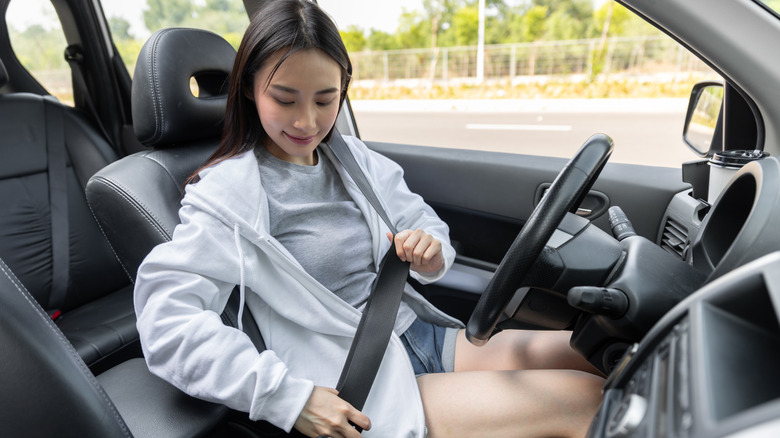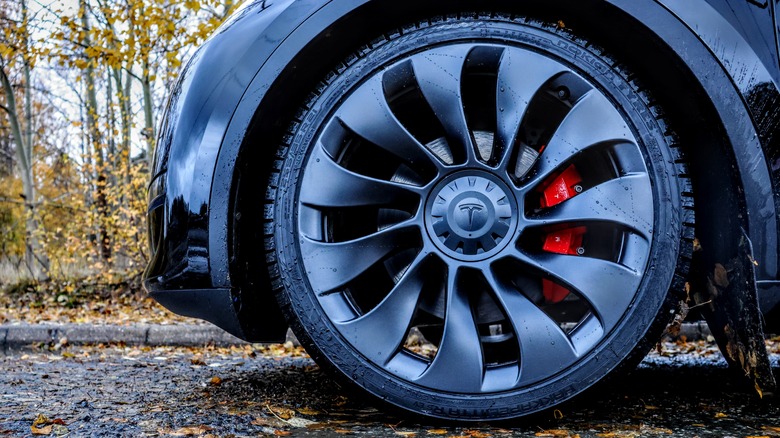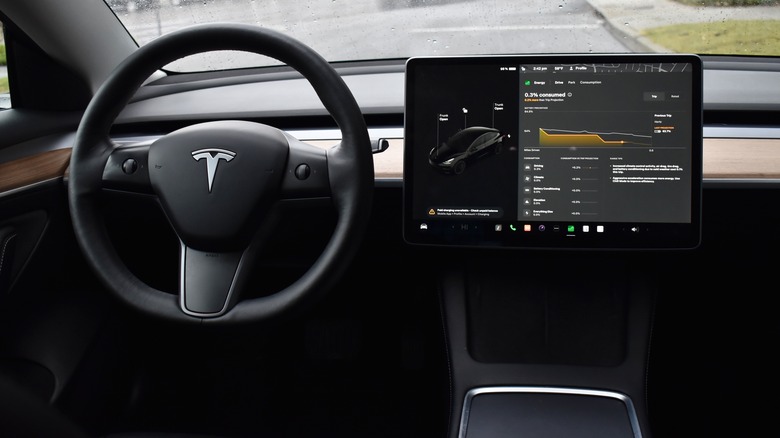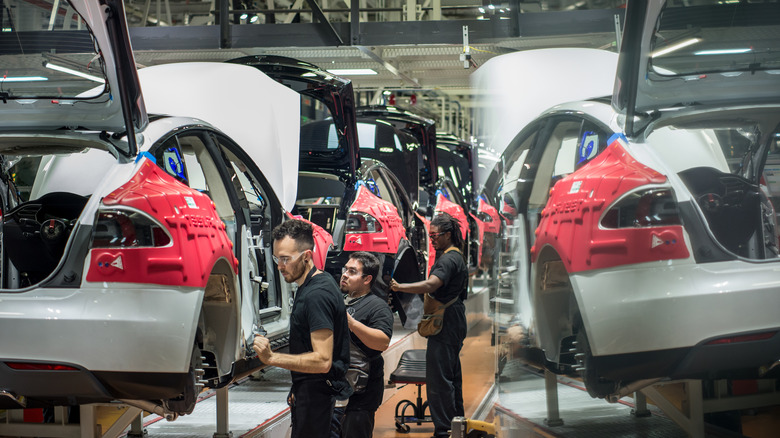9 Of The Most Dangerous Reasons For Tesla Recalls So Far
If there's one company that never fails to stay out of the internet spotlight, it's Tesla. Whether it's Elon Musk putting his foot in his mouth with his latest antics or news of a massive backup at the local Supercharger, it seems America's homegrown EV company can't catch a lucky break. And, well, some of that heat is self-inflicted. The leading headlines for Tesla either have to do with a new vehicle announcement or a massive recall. Recalls conjure images of battery fires and self-driving crashes when it comes to EVs, but what actual danger have Tesla vehicles risked their users with?
Quite a lot, it turns out, even if that danger didn't lead to many injuries or death. Some recalls in recent years have been downright terrifying, and Tesla wasn't always so quick to alert affected owners — several forced regulatory agencies to step in. Several ended up being no big deal. Whether you are just curious or a prospective Tesla owner, here are nine of the most dangerous recalls in the company's history.
Stuck accelerator pedal, Cybertruck - 2024
The Cybertruck has had it rough since day one — ironic, since it was marketed to conquer rough terrain but struggles to. The biggest news of its 2019 reveal event was a stage presenter shattering both of its "armor glass" windows with a steel ball. It then appeared several years late with an unexpectedly high launch price and a slew of problems. Less than a year after release, it got hit with a recall. According to Tesla's support page, "when high force is applied to the pad on the accelerator pedal, the pad may dislodge, which may cause the pedal to become trapped in the interior trim above the pedal." In other words, the gas would get stuck if a Cybertruck owner tried to floor it, perhaps in imitation of the promotional video where a Tesla outsprints a Porsche 911 while towing one.
The official NHTSA Safety Recall Report says, "An unapproved change introduced lubricant (soap) to aid in the component assembly of the pad onto the accelerator pedal. Residual lubricant reduced the retention of the pad to the pedal." Translation: they lubed the Cybertruck in the wrong places. The recall affected 3,878 Cybertrucks manufactured between November 2023 and April 2024 — every unit manufactured since launch up until that point.
One affected owner told NBC News that once the accelerator was pinned, the only way he could stop the vehicle was by keeping a foot on the brake. "The moment I let go of the brake, it would lurch forward at full throttle again," he said. According to Tesla, the stuck pedal didn't do any harm, and it was a relatively simple fix made free of charge. However, there was a pause in Cybertruck deliveries shortly after.
Autosteer abuse recall, multiple models - 2023
On December 12, 2023, Tesla recalled 2 million vehicles in the US and Canada — the largest recall to date. It included its Model S, Model X, Model 3, and Model Y vehicles produced between October 5, 2012, and December 7, 2023 — almost all the models it makes. The reason? Users were abusing the Autosteer function. Teslas are not full self-driving (FSD) vehicles; the self-driving features require the driver to pay close attention to the road at all times and be ready to intervene at a moment's notice. Still, the vehicle can do most of the driving, enough for drivers to risk some pretty abhorrent things.
Videos abound on the internet of drivers literally asleep behind the wheel. One sleeping driver barrels down one of LA's busiest highways; another in Temecula snoozes for at least 15 minutes at high speed; another in Ontario had their seat reclined all the way back doing the same; and one in Wisconsin was hitting 80 MPH. Others likely abused Autosteer for different purposes, such as scrolling Instagram or applying makeup. Tesla vehicles are supposed to monitor the driver and automatically disable self-driving features if they aren't paying attention, but that wasn't triggering correctly. The December 12 update appears to address this long-standing issue.
This recall was a long time coming. Tesla has already been under criminal investigation in relation to its FSD claims, particularly concerning almost 1,000 crashes involving Autopilot. That said, "recall" here only means a free software update. Owners could continue driving their vehicles and do an over-the-air (OTA) update at their convenience. After the fact, though, the Fed wasn't convinced the problem was solved.
Autopilot recall in China, multiple models - 2024
While ever fewer people are driving EVs in the US, The EV market in China is booming; 60% of international sales come from the PRC, according to IEA. While Tesla is available in China, it has stiff competition. Thus, it was probably a heavy blow when Tesla issued a recall for 1.6 million vehicles, specifically Model S, Model X, Model 3, and Model Y vehicles manufactured between August 2024 and December 2023, according to a machine translation of the Chinese State Administration for Market Regulation. To be clear, this recall is separate from the 2 million vehicles recalled in the United States, but it's for the same reason: abuse of the Autosteer function.
This was another OTA recall. According to the recall information, only a small number of users would be unable to install the upgrade themselves and would need to head to a Tesla service center. Given the language barrier with Chinese state media, it's difficult to tell what sorts of abuses were happening to provoke this recall. We can only assume drivers were engaging Autosteer to take naps like American Tesla owners — or perhaps the system failed them while fully alert. There have been crashes in China attributed to Tesla's Autopilot as far back as 2016.
This is not the only Tesla recall in China. In the same 2024 recall report, another 7,538 Model S and Model X vehicles had doors that would unlatch in a collision. In 2023, Tesla also had a recall for a braking issue that affected 1.1 million vehicles. These issues don't bode well for Tesla if it intends to compete with its Chinese alter ego, BYD, a fierce competitor that has already revealed a hybrid vehicle with over 1,000 miles of range.
Full self-driving beta software recall, multiple models - 2023
The late 2023 recall was not the first recall of that year, nor the first for self-driving-related features. On February 15th, 2023, Tesla issued a voluntary recall for 362,758 vehicles enrolled in the full self-driving beta. This recall affected the Model S, Model X, Model 3, and Model Y manufactured between 2016 and 2023, but only for vehicles in the US and Canada. According to the NHTSA, "when the feature is engaged, the feature could potentially infringe upon local traffic laws or customs ... before some drivers may intervene." The report specifies that FSD beta-enabled vehicles might go through intersections on a stale yellow light, struggle with intersection stop signs, fail to keep to speed limits, or make last-second lane changes when already in a turn lane. In other words, the vehicles would make incredibly risky decisions before the driver could assume control.
Tesla made this recall in response to the NHTSA, which reported on January 25th of the same year that it had identified the concerns mentioned above. Thankfully, there were no injuries or deaths related to FSD beta as of February 14th, and this was another OTA patch that didn't require customers to come into a service center. The patch started going out on March 6, 2023.
YouTuber Marques Brownlee uploaded a twenty-minute drive demonstration of the FSD beta on December 15th, about two months before the recall. In the video, Brownlee has to intervene multiple times to keep the vehicle out of trouble. His Tesla slows to a crawl long before one turn, struggles to merge onto a highway, and almost crashes into a toll gate — among other things. FSD beta debuted in the fall of 2021, so one wonders how bad it was prior to the recall update.
Faulty seatbelts, Model S - 2015
At first glance, a faulty seatbelt sounds like a nightmare situation, but Tesla was very quick on the trigger to fix this issue in their Model S. It all began in 2015 when one European customer turned to speak to a backseat passenger, which caused the outboard lap pretensioner to detach from the seatbelt. That component is meant to lock the seatbelt when you get in a crash. Just one bolt led to the recall of 90,000 vehicles, or every Model S manufactured up to that point. Obviously, a seatbelt disconnecting just because you turn around will provide next to no protection in a collision, but the lone incident where this happened did not result in any injuries, nor is there evidence of injuries in other Model S vehicles from the same issue.
Tesla tried to replicate this issue in 3,000 vehicles that it had on hand but was unable to do so. To Tesla's credit, they did the right thing and enacted a voluntary recall. Owners were instructed to schedule an inspection with a Tesla technician and were shown how they could test it themselves. Regardless, this whole situation could have potentially been much worse if a life-threatening crash was the event that revealed the flaw.
Seats slide forward during collision, Model X - 2017
Seatbelts weren't the only things coming free when they shouldn't. In Model X vehicles manufactured between 2016 and 2017, the second-row seats would move forward on impact during a crash. The cause of the issue was, according to the Automotive Safety Council, "due to having incorrectly adjusted recliner mechanism cables." This violated Federal Motor Vehicle Safety Standards (FMVSS) and was, well, clearly a glaring safety issue. Owners with affected vehicles were able to get a free fix by October 2017 with Tesla's mobile service. It would appear that there were no accidents or injuries resulting from this specific recall, and only 11,000 vehicles were affected. Tesla did not advise owners to stop driving their vehicles until repair, but it cautioned against having two adults sit on the affected seats — presumably because the extra weight would make the seat more likely to spring forward.
Searching for this specific recall on Google yields a dead NHTSA link, and it appears that Tesla no longer shows the recall on its website. We assume this is because the problem was fixed, and there are no longer any affected models. In any case, it's scary to imagine those backseats shooting forward during a crash, potentially giving backseat passengers whiplash and bludgeoning them against the front seats. This small recall didn't get many headlines, but it raises yet more concerns about Tesla's quality control standards. One wonders what would've happened it were not caught earlier.
Seatbelt recalls, Model 3 and Model Y - 2021-2022
Tesla's seatbelt woes were not over after the 2015 Model S debacle. Three more seatbelt recalls followed in 2021 and 2022, affecting two particular models in three separate instances. It began with a May 25, 2021, recall for 5,530 Tesla Model 3 and Model Y vehicles manufactured in 2018-2020 and 2019-2021, respectively. The NHTSA report says that in both models, the "driver and front-passenger shoulder belt portion of the seat belt system is attached to the b-pillar through a top loop... [and] during assembly, one or both fasteners may not have been secured to the correct specifications." As with the previous seatbelt issues, the concern is that these belts would not pass muster in a collision. This issue was first discovered at a Tesla Service Center on March 17, 2021, which triggered an internal investigation and unveiled some manufacturing issues. There were no crashes or injuries and affected users were able to get a free repair.
Shortly after, another recall addressed a seatbelt retractor that was not securely attached in the Tesla Model Y. It affected 2,166 units manufactured between 2019 and 2021, per an Automotive Safety Council overview of NHTSA recalls. It's not clear if there were any related accidents or injuries. The following year, on October 21, 2022, yet another recall hit the Model 3, this time for models between 2017 and 2022. In the latter case, it appears the recall resulted from improper Tesla servicing meant to fix seatbelt issues. Still no injuries or crashes, but this marks four separate seatbelt-related recalls in half a decade.
Phantom braking, Model S, X, and 3 - 2021
Phantom braking has been a perennial scare among Tesla owners. When it happens, the vehicle will slam on the brakes without any apparent reason or obvious danger, often at a very inopportune moment — such as moving at speed on the highway. In other words, it risks you getting rear-ended and possibly causing a pileup. On October 29, 2021, Tesla put out a recall for 11,704 units of the Model S, Model X, and Model 3, all manufactured between 2017 and 2021. The NHTSA describes the issue as: "A software communication error may, under a certain sequence of events, result in false forward-collision warnings (FCW) and/or automatic emergency brake (AEB) events." Apparently, this particular instance of phantom braking was caused by an FSD beta software update 10.3 released on October 23rd. This was another OTA recall on affected vehicles where Tesla quickly canceled the problematic update, rolled it back, or (later) updated software to a patched version.
Unfortunately, this was not the end of phantom braking. Next year, the NHTSA had accumulated 758 complaints about phantom braking and demanded that Tesla investigate the issue. More alarming was the fact that there had been more complaints since the recall than prior to it, triggering an NHTSA probe with the possibility of forcing an official recall of 416,000 vehicles — the fourth such investigation in three years. There was also a class-action lawsuit earlier that year from Tesla owners whose vehicles had exhibited phantom braking. This is an ongoing problem, as reports continue to trickle into the end of 2023, and we have evidence of crashes likely caused by it.
Potential future recall for steering issue, Model 3 and Y - 2023
So far, the recalls we have mentioned are only the most concerning and dangerous; they comprise only a small slice of all Tesla recalls on the historical record. There are still more to come, and a power steering issue that's cropped up may prove to be the next. On July 28, 2023, the NHTSA investigated 280,000 Model 3 and Model Y vehicles in response to user complaints, plus reports they obtained of their own accord. Complaints ranged from an unresponsive steering wheel to users feeling they couldn't steer safely to start with. In one case, a user lost control of the vehicle and crashed into a tree, and in another, someone caused a collision after the steering wheel did not allow them to turn all the way.
By February 1st, 2024, The Office of Defects Investigation (ODI, part of the NHTSA) upgraded its preliminary evaluation to an engineering analysis. The investigation now includes approximately 2,191 failure reports and encompasses 334,569 affected vehicles. According, the Engineering Analysis, "has been opened to characterize the conditions leading to — and stemming from — failures with steering rack part." So now that we know it's a steering rack failure, the only question that remains is when an official recall will happen and how Tesla will respond.
Why Teslas are having so many recalls
From a statistical perspective, Tesla isn't breaking records in recalls. If we look at the NHTSA recall data, it doesn't even come close to the recall quantity of Chrysler, Ford, Kia, and other major brands — though that picture would probably look different if you compared the percentage of recalled vehicles for each versus their production numbers. And to give Tesla the benefit of the doubt, they are pushing for FSD, an incredibly difficult mountain to climb that we're still a long way from summitting — one Elon keeps assuring we're right around the corner from. Frequent bugs — especially after Tesla stopped using the superior ultrasonic sensors in favor of a full-camera system — are to be expected. Thankfully, FSD-related recalls simply require an OTA.
On the flip side, Tesla has an embarrassing quality control record. A JD Power Initial Quality Study ranked Tesla near the bottom. If you lurk on Tesla forums, you will find owners complaining about recurring issues in build quality. Take the infamous panel gap problem; Reddit user u/Automatic_Revenue348 posted a picture asking about the panel gaps in their Model 3, and the top comment reads: "Oh, you sweet thing. You must be new here." Some build quality issues are less common; once, a Model Y user found that their cooling system had been secured with faux wood trim. And so on.
It's difficult to identify the root cause, but the poor quality probably isn't helped by a CEO who lies about his pledges to safety, runs chaotic work environments, and builds a high-pressure work culture. Tesla has also been the subject of numerous lawsuits. And if that weren't bad enough, the company will sometimes blame customers for its part failures. It's hard to imagine a future with fewer recalls.
